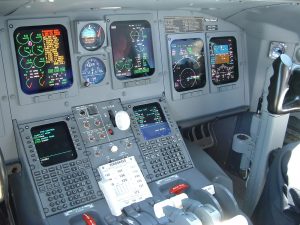Artificial General Intelligence In Flight Operations
 The aviation industry, known for its complex systems, strict safety regulations, and high operational demands, is on the brink of a technological revolution driven by Artificial general intelligence. While artificial intelligence has been used for specific applications in aviation for years, AGI, an advanced form of AI with the ability to understand, learn, and apply knowledge across a wide range of tasks, is set to redefine the role of airline pilots and transform flight operations as a whole.
The aviation industry, known for its complex systems, strict safety regulations, and high operational demands, is on the brink of a technological revolution driven by Artificial general intelligence. While artificial intelligence has been used for specific applications in aviation for years, AGI, an advanced form of AI with the ability to understand, learn, and apply knowledge across a wide range of tasks, is set to redefine the role of airline pilots and transform flight operations as a whole.
AGI differs significantly from narrow AI, which is typically designed to solve specific problems. Unlike narrow AI, which excels at a single task like flight route optimization or voice recognition, AGI can perform a variety of tasks, adapt to new environments, and even make complex decisions across diverse situations. This makes AGI a game-changer for the aviation industry, where pilots are tasked with managing not only the aircraft itself but also environmental factors, safety concerns, and real-time decision-making.
This article delves into how AGI could assist airline pilots in flight operations, enhancing safety, efficiency, decision-making, and overall flight performance.
Artificial general intelligence
Artificial general intelligence refers to a machine’s ability to perform any intellectual task that a human being can. Unlike current AI technologies, which are typically specialized for specific tasks, AGI has the potential to understand and learn new skills autonomously across a broad range of domains. It can integrate information from diverse sources, reason through complex problems, and adapt to unfamiliar situations—mimicking human cognitive abilities.
In the context of aviation, AGI is more than just an automation tool for specific tasks like navigation or weather prediction. It has the capacity to assist pilots in real-time by offering contextual decision support, anticipating challenges, and providing solutions in a dynamic and evolving environment.
Enhancing situational awareness
The primary role of airline pilots is maintaining situational awareness, that is understanding and interpreting the aircraft’s position, altitude, speed, and orientation, while also being aware of the broader environmental factors such as weather, air traffic, and terrain. AGI can significantly enhance situational awareness by processing vast amounts of data from a variety of sources, including radar, sensors, satellite systems, and weather forecasts.
1) Data integration from multiple sources
AGI systems can gather and integrate data from multiple sensors and external sources, such as weather systems, air traffic control, and other aircraft in the vicinity. With this integrated data, AGI can create a real-time, comprehensive understanding of the flight environment, far surpassing the capabilities of traditional cockpit systems.
For example, AGI could analyze weather patterns, turbulence, and wind conditions in real time, adjusting flight routes or advising pilots on the best course of action. In busy airspaces, AGI could monitor air traffic movements and predict potential conflicts, providing pilots with early alerts and safe course adjustments. This level of situational awareness allows pilots to make better-informed decisions, improving flight safety and reducing human error.
2) Predicting potential risks
AGI’s ability to analyze patterns and make predictions is another valuable asset in flight operations. By analyzing historical flight data, AGI can predict potential risks or challenges, such as turbulence, thunderstorms, or adverse changes in air traffic. With predictive capabilities, AGI could advise pilots on precautionary measures, such as altitude adjustments, alternate routes, or diversions to avoid these risks.
3) Automated data interpretation
AGI can rapidly interpret complex data from a variety of sources in real time, reducing the cognitive load on pilots. For example, rather than manually analyzing radar data, AGI could instantly process information from weather radar, system diagnostics, and flight trajectory to present pilots with actionable insights in an easy-to-understand format. This automated data interpretation reduces the likelihood of human error and allows pilots to focus on critical decision-making.
Improving decision-making during emergencies
In emergency situations, the speed and quality of a pilot’s decision-making can make the difference between life and death. AGI, with its ability to process vast amounts of data quickly and intelligently, could significantly enhance a pilot’s decision-making ability in high-stress situations.
1) Real-time decision support
In a crisis, AGI could assist pilots by quickly analyzing the situation, evaluating the severity of the emergency, and offering recommendations for the best course of action. For example, if an engine failure occurs mid-flight, AGI could instantly calculate the most efficient emergency landing options, factoring in wind speed, terrain, distance to the nearest airport, and other critical variables. AGI could also provide step-by-step guidance on managing the failure, troubleshooting potential issues, and coordinating with air traffic control for a safe landing.
2) Managing system failures
Modern aircraft are equipped with a complex array of systems that monitor flight operations. However, when a failure occurs—be it in navigation, communication, or mechanical systems—pilots are often required to make rapid decisions to address the issue while maintaining control of the aircraft. AGI could continuously monitor system health and intervene in situations where manual adjustments are required, providing both decision support and recommendations for resolving the issue.
For example, if a critical system failure occurs, AGI could analyze the problem, cross-check available alternatives, and provide the pilot with an optimal course of action. AGI would ensure that no vital information is overlooked, enhancing the overall safety of the flight.
3) Assisting with human error reduction
Human error remains one of the leading causes of aviation incidents. AGI could reduce this risk by acting as an intelligent assistant, double-checking pilots’ actions, and offering reminders or prompts in case of oversight. For instance, if a pilot forgets a checklist item or fails to configure certain flight systems during a critical phase of flight, AGI could offer a gentle reminder or alert, preventing potentially dangerous mistakes.
Flight path optimisation and fuel efficiency
AGI’s predictive abilities extend to flight planning and route optimization, both of which play a crucial role in maximizing efficiency, reducing fuel consumption, and minimizing delays. While modern flight management systems already provide optimisation tools, AGI has the potential to take this a step further by factoring in more dynamic and real-time variables.
- Dynamic route adjustments: Traditional flight path optimisation often relies on predefined routes or simple weather data, but AGI can continuously adapt flight paths based on a wider range of real-time variables. For instance, AGI could consider fluctuating wind speeds, congestion in nearby airspace, real-time weather conditions, and even changes in the airline’s fleet availability. By analysing all these factors, AGI can suggest adjustments to the flight plan to save fuel, avoid delays, and enhance overall operational efficiency.
- Fuel efficiency and carbon footprint reduction: Fuel efficiency is a key concern in modern aviation, not just for cost savings but also for sustainability. AGI can help airlines minimize fuel consumption by suggesting optimal cruising altitudes, more efficient routes, or ways to avoid fuel-wasting weather phenomena like headwinds or thunderstorms. Furthermore, AGI can continually learn from past flights and predict fuel-efficient strategies based on historical data, adjusting tactics as conditions evolve.
- Real-time air traffic management: As air traffic grows, the complexity of managing flight routes and maintaining safe separation between aircraft becomes more challenging. AGI could assist pilots by providing real-time air traffic management support, including dynamic route adjustments to avoid congested airspace or optimize flight sequencing. By proactively adjusting flight paths to avoid delays and improve flow, AGI helps reduce fuel consumption and enhance on-time performance.
Enhancing pilot training and skill development
In addition to assisting pilots during flight operations, AGI can play an important role in pilot training and skill development, providing a level of personalised, adaptive learning that is difficult to achieve through traditional methods.
1) Simulating complex flight scenarios
AGI-powered training systems could simulate a wide range of flight scenarios, including emergencies, difficult weather conditions, or high-stress situations. These simulations would not only be more realistic and adaptive than current systems but also offer an environment where pilots can practice decision-making under pressure without the risks of real-life consequences.
AGI could adjust the complexity of training sessions based on the pilot’s performance, allowing them to progress at their own pace and continually challenge their skills. By providing personalised feedback and adaptive learning, AGI systems ensure that pilots are constantly improving, refining their decision-making abilities, and learning new techniques.
2) Analysing pilot performance
AGI can analyze and track pilot performance across training sessions, identifying areas of strength and weakness. By using this data, AGI can create targeted training modules to address specific areas of improvement. For instance, if a pilot is consistently struggling with certain manoeuvres, AGI can suggest additional practice in that area or simulate relevant scenarios that will help improve skills.
3) Real-time performance monitoring during flights**
AGI can also be used during actual flights to monitor a pilot’s performance in real-time, offering suggestions or interventions when necessary. For example, if a pilot is flying in challenging conditions, AGI could offer reminders about certain procedural steps or provide insights on the best way to manage the situation. By ensuring that pilots have access to continuous learning, AGI helps ensure that they remain proficient and up-to-date with the latest techniques and procedures.
Future of AGI in flight operations
As AGI continues to evolve, its role in aviation will expand. Beyond assisting pilots in flight operations, AGI could eventually evolve into a fully integrated system that collaborates with flight crews, air traffic control, and even autonomous aircraft systems. In the long term, AGI may even assist in the development of new aircraft designs, provide real-time analytics for airlines, and optimize entire air traffic networks to improve safety and efficiency on a global scale.
However, integrating AGI into flight operations will require careful consideration of safety, ethical issues, and regulatory frameworks. While AGI has the potential to revolutionise aviation, human oversight and accountability will remain essential to ensuring that these technologies operate safely and effectively.
Wrapping up
Artificial General Intelligence holds transformative potential for the aviation industry, offering significant benefits in the areas of flight operations, safety, decision-making, and efficiency. From enhancing situational awareness to optimizing flight paths, improving pilot training, and assisting with real-time decision-making during emergencies, AGI can be a valuable tool for airline pilots.
By integrating AGI into flight operations, the aviation industry can increase safety, reduce human error, optimize resource use, and improve the overall flying experience. While there are challenges to overcome in terms of implementation and regulation, the future of AGI in aviation is undoubtedly bright, promising a new era of smarter, more efficient, and safer air travel for both pilots and passengers alike.










